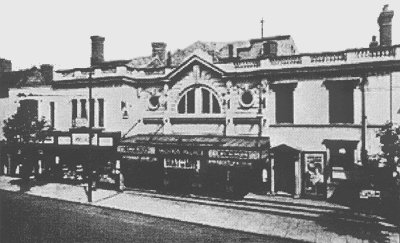Possibly the last of the early batch of cinemas in the town was
the Globe which was built on the original site of the
Hollingsworth's Pork Sausage & Pie Factory in Horseley Fields (the
area which includes the town end of the Willenhall Road). The Globe was
the initiative of a Capt. Cresswell. The cinema's entrance was in
Mary Ann Street. It had a small foyer and a relatively small auditorium
designed for 600 patrons. The entrance had a canopy with the cinema's
name on it. It opened on January 24th 1927 with the film 'Midnight
Sun.
The surrounding areas of Wednesfield and Bilston had their own early
cinemas. In the village of Wednesfield the first premises to be used for
the showing of films was a former Methodist chapel situated in Rookery
Street (the final section of the main Wolverhampton/Wednesfield Road).
The chapel was built in 1852 and used for religious services for over 30
years. By the early 1900's it was a public hall. There are records of
films being shown at the hall in 1912/1913 but no record of any public
opening of a cinema. It was known originally as the Picture House.
Descriptions of the earliest building speak of an entrance at the
furthest end of the building i.e. the Wyrley & Essington Canal end and
the screen at the Rookery Road end. This may have been a product of the
relatively busy nature of the road and therefore a danger to cinema
patrons! The Picture House was to become the Ideal in about 1931
and remained the village's only cinema for about 20 years (although
there are some references to the Tivoli or Palace Electric
Theatre in the High Street in 1910 but little more information
remains).
Bilston's early cinema history is dominated by the activities of the
Wood family. The patriarch of the family was Joseph Wood who
was born in Northumberland in 1842. He moved to Liverpool where he set
about gaining an education for himself, concentrating on areas of study
like anatomy and physiology. He began giving lectures, accompanied by
magic lantern slides which were organised by his son, Thomas Reay
Wood.

Earliest photograph of the original Wood's
Palace. |
The elder Wood became known as Professor and in 1896
he obtained a cinematograph which his son used quite extensively. In
1910 the Woods settled in Bilston and began showing films in a room
at the Town Hall which was advertised as Wood's Palace. In
1919 the Wood family leased the Electric Palace which was
opposite the Town Hall in Church Street. |
The Electric Palace had opened in 1913 and was
owned by the Bilston Electric Theatre Ltd. It had accommodation
for 350 people, seated mainly downstairs but it also had a small
balcony. The Electric Palace ceased operating in the spring of 1921.
About a year before the opening of the Electric Palace, another Bilston
cinema, the Alhambra,
had opened. It was another of Thomas Jackson's cinema empire.
It had an entrance which opened onto the High Street but it was part of
a terrace or parade of shops rather than a single building. It did not
really look like a cinema. Once again the bankruptcy of Thomas Jackson
led to the sale of the Alhambra. The Woods acquired the lease and
showed films at the Alhambra until 1927.
On November 17th 1921, the Woods opened their most
splendid cinema yet, the new Wood's Palace in Lichfield Street.
The new Palace cost in the region of £3000 (a very large sum for the
time) and incorporated a cafe and billiard room. The auditorium was
luxurious with very vivid colours. The seating was purple and the cinema
could accommodate about 1400 people. There was a balcony and orchestra
pit and also changing rooms for variety artists, when it was used as a
music hall or theatre. According to the ageing Professor Wood:
'The people of Bilston deserve the very best!'
In comparison to most of the cinemas in the area Wood's Palace really
stood out and the people of Bilston had the very best! The expiry of the
lease on the Alhambra in 1927 was quickly followed by the opening of
another Wood cinema, the Savoy, directly across the road.
Once again it was built into a parade of shops.
| The auditorium held 750 people but it had no
balcony. However, the front rows sloped up towards the screen to
provide a better view for those patrons sitting at the front
(probably at a price!). It was the first local example of a cinema's
name being chosen by its patrons. It opened on October 10th 1927, by
which time Professor Wood was dead. |

The 'new' Woods Palace, Bilston. |

















